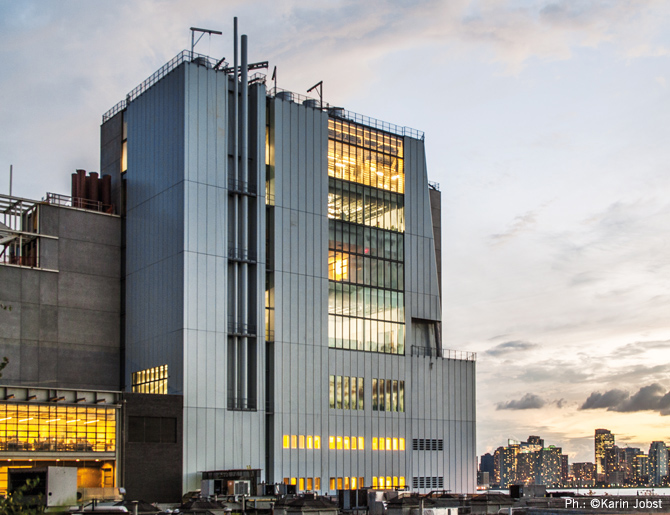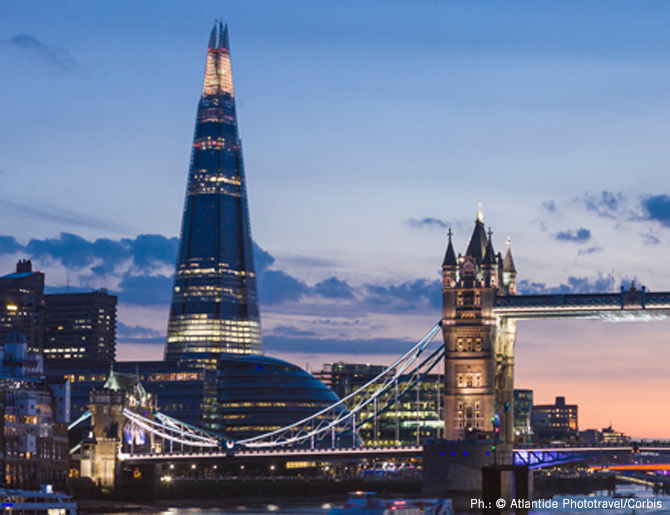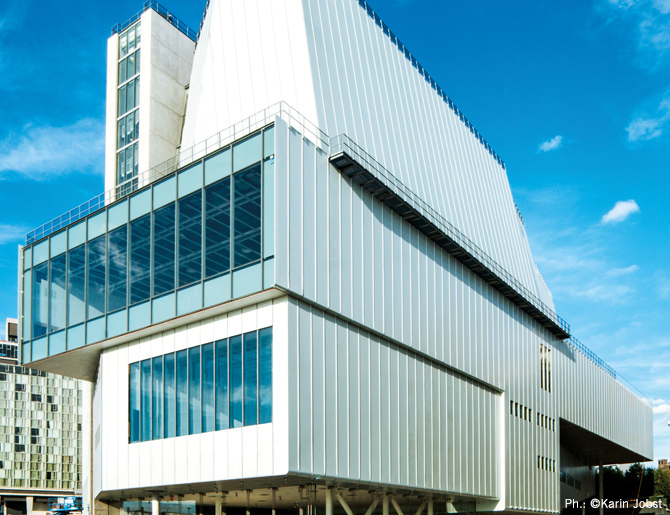LIXIL makes pioneering water and housing products that solve everyday, real-life challenges, making better homes a reality for everyone, everywhere.
- Global Site
-
- English
- Japanese
- Brand Sites
Global
- Global Site
-
- English
- Japanese
- Brand Sites
Updated: Mar 26, 2017
 Whitney Museum of American Art
When Weill Cornell Medical College hired Ennead Architects to design a new glass research building, the southern sun was their main challenge. Ennead wanted to create an elegant glass structure that would comfort patients, unlike some of the college's older buildings that were cold and institutional. But a traditional glass wall facing the southern sun would quickly overheat the facility and obscure the sweeping views of midtown Manhattan and Queens.
Whitney Museum of American Art
When Weill Cornell Medical College hired Ennead Architects to design a new glass research building, the southern sun was their main challenge. Ennead wanted to create an elegant glass structure that would comfort patients, unlike some of the college's older buildings that were cold and institutional. But a traditional glass wall facing the southern sun would quickly overheat the facility and obscure the sweeping views of midtown Manhattan and Queens.
The team conceptualized the idea of anchoring a double glass curtain wall on the exterior of the Belfer Research Building to create a multi-chamber chimney through which the heat could escape. Ennead founding partner Todd Schliemann noted that this was the first time the firm would carry out this type of project on a high-rise structure. Because Ennead was working with the Permasteelisa Group, the world's leading maker of cutting-edge curtain walls that form building facades, Schliemann said the team was confident it could pull off the feat.
"They're very good at the adventurous part of design, and they make beautiful things," said Schliemann. "The architecture has to have a good bedside manner, and those facades are a big part of it."
Permasteelisa provides the architectural envelopes that cover many of the world's most iconic buildings. Based in Vittorio Veneto, Italy, and acquired by LIXIL in 2011, the company collaborates with Frank Gehry, Norman Foster, Rem Koolhaas and other star architects to drape buildings like The Shard in London, FO1 New York's IAC headquarters and the Sydney Opera House with sophisticated curtain walls that set the standard for architectural beauty and engineering prowess.
 The Shard
"We are called on when there is something one-of-a-kind, and this bespoke project carries a challenge in terms of design, engineering and logistics," said Riccardo Mollo, the Chief Executive Officer of Permasteelisa.
The Shard
"We are called on when there is something one-of-a-kind, and this bespoke project carries a challenge in terms of design, engineering and logistics," said Riccardo Mollo, the Chief Executive Officer of Permasteelisa.
In recent years, the number of people living in cities has surpassed that of rural populations. Navigant Research reports that this surge in urban population growth is expected over the next decade to drive an equally rapid expansion in commercial and residential buildings, as cities demand both economic housing solutions and monuments of their wealth. Global building stock is expected to grow 24% from 138.2 billion square meters in 2013 to 171.3 billion in 2023, estimates Navigant.
A company like Permasteelisa is a key enabler of the global building boom—helping builders to meet increasingly rigorous standards for sustainability and security while also achieving feats of creative daring. Founded in 1973, it operates a network with around 7,000 employees across more than 50 companies and last year reported almost US$2 billion in revenue, said Mollo. Eighty percent of its business derives from curtain walls, with the remainder coming from interior decoration contracts in hotels, retailers and airports. It is currently focused on the North American and Northern European markets, and is expanding in Asia and the Middle East. Mollo estimates Permasteelisa has worked on 170 buildings in New York alone, and another 210 in London.
"We have shaped the skylines in major cities," Mollo said.
Permasteelisa has played a key role in helping LIXIL become a more global company, said Mollo. Permasteelisa can manage a project from the beginning to the end in a truly networked approach, with an operation that includes 14 factories around the world.
"We can build something in Germany for a building in New York," said Mollo. "We have a unique model for the delegation of authority and cross-fertilization."
With this carefully choreographed system of manufacturing, logistics and procurement, Mollo describes the company's philosophy in terms of Plato's concept of Demiurge, which in Greek means craftsman or artisan. In the Platonic philosophy, the Demiurge is a divine figure responsible for bringing order to the physical universe. When an architect like Renzo Piano, Frank Gehry or Norman Foster conceives a building design, Permasteelisa sits down with them from the beginning to see what is possible. "Our role is to turn an architect's idea into something that is feasible from both 2 an engineering and economical viewpoint," said Mollo.
At the Belfer Building, which opened in 2014, Permasteelisa engineers were not only able to engineer and manufacture the double curtain wall, they also developed an advanced technique to install the wall in large units with cranes, which saved the developer time and money. Thanks to the building's design, said Schliemann, its energy costs are 20% lower, helping it earn a LEED Gold rating, the second-highest certification for building sustainability.
When Lord Norman Foster designed Hearst Tower, which was completed in 2006, the challenge involved installing a new building like a layer cake on top of the former building that was built in 1928. Permasteelisa worked with Foster + Partners to make the project feasible and to manufacture a facade using a new technology called "bomb blast," which can withstand the pressure of heat from an explosion. This same technology is used on the podium of One World Trade Center.
The design helped the Hearst Tower win the first U.S. Green Building Council LEED Gold status and later LEED Platinum certification for a New York commercial building, due in part to Permasteelisa's help in engineering the waterfalls in the building's lobby. The waterfalls are not just decoration; they also boost the energy efficiency of the entire building. Rainwater that gathers on the roof is channeled to the waterfalls. "In the summer, it contributes to the air-conditioning," said Mollo.
 Whitney Museum of American Art
Sitting on the edge of lower Manhattan, the new Whitney Museum of American Art, which opened in May 2015, looks like an industrial spaceship docked in the port of the revitalized Meatpacking District. Designed by Renzo Piano Building Workshop in collaboration with architecture firm Cooper Robertson and Josef Gartner GmbH, the structure is a feat of modern engineering.
Whitney Museum of American Art
Sitting on the edge of lower Manhattan, the new Whitney Museum of American Art, which opened in May 2015, looks like an industrial spaceship docked in the port of the revitalized Meatpacking District. Designed by Renzo Piano Building Workshop in collaboration with architecture firm Cooper Robertson and Josef Gartner GmbH, the structure is a feat of modern engineering.
In 2001, Permasteelisa bought Josef Gartner, a boutique German engineering firm specializing in aluminum and steel building envelopes. Gartner designed many of the Whitney's unique architectural elements, such as the steel curtain wall system that gives the museum its shape. As it continues to push the boundaries of architecture and engineering, Permasteelisa's Mollo said the company is inspired by a grand ambition: "We want to leave a heritage for humanity."
Our Stories
- Backing People and Passions to Drive Innovation
- How Toilets in Schools are Catalyzing Change in Communities
- Building the Future by Recycling the Past
- Reinventing Consumer Connections in the World's Largest E-commerce Market
- Tackling Household Water Inefficiency in a Water-Stressed World
- Plugging the Plumber Shortage
- Pioneering Solutions to a Sewage Crisis in Rural Alabama
- Meet the Citizen Developers Changing How We Work
- Design and Brand Identity Transformation at LIXIL
- Three Changes to Prepare Europe’s Sanitary Industry for Growth
- Three Steps to Creating an Inclusive Culture
- From Linear to Circular: Giving Products in Your Home a New Lease of Life
- Crafting Unique Experiences as well as Products
- GROHE X: A Digital Brand Experience
- Design-led Innovation Delivering True Value
- Responsible Use of Plastics
- Empowering our People for an Agile Future
- Turning the Waves of Change into Opportunities
- SATO Tap: a New Handwashing Solution for All
- New Ways of Working Take Flight at LIXIL
- INAX: Rituals of Water
- Refreshing our sanitation targets, standing firm on our commitments
- Developing Attractive and Differentiated Products
- Conserving Water: The New Normal
- Insulating For a Warmer and Healthier Home
- Open Kitchen, Open Communication
- Tackling Open Defecation in India
- Shaping the Future of Faucets, One 3D Layer at a Time
- Bathed in Culture and Tradition
- Remodeling the Housing Market
- LIXIL's AQUA CERAMIC makes bathroom stains a thing of the past
- The Technology of Water
- Tackling Challenges in Global Sanitation and Hygiene
